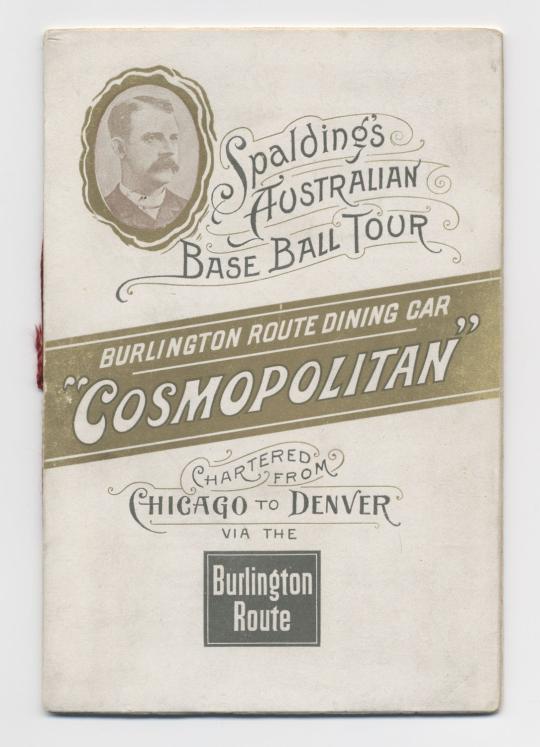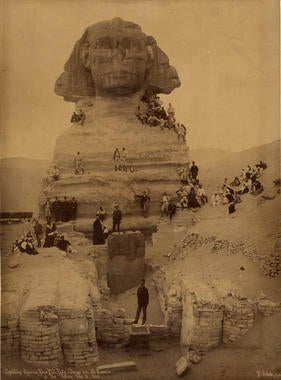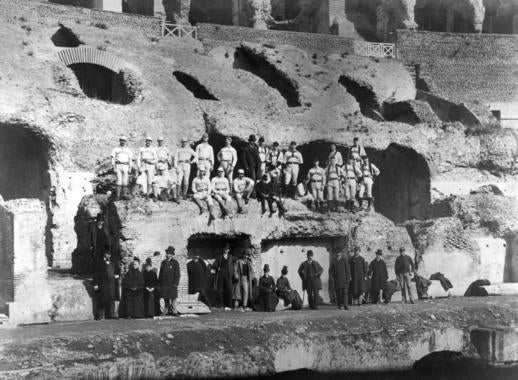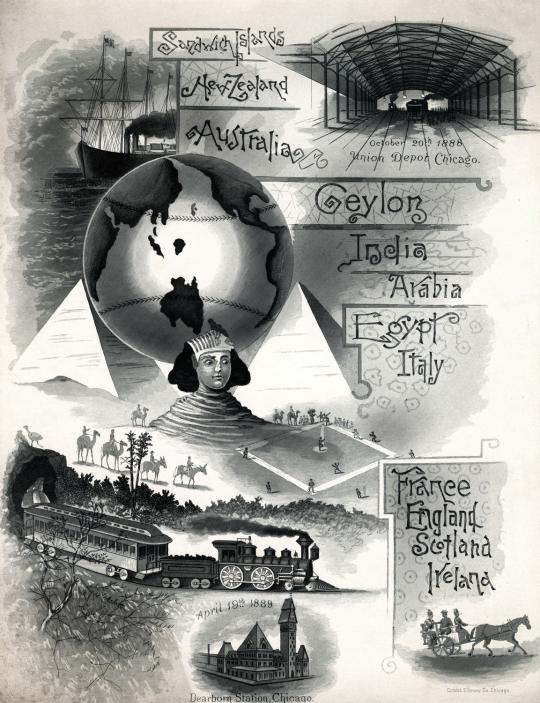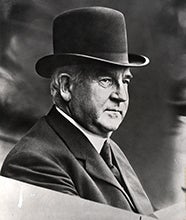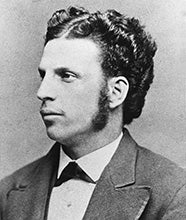- Home
- Our Stories
- Road Trip
Road Trip
More than 125 years ago, in late October 1888, two baseball clubs and an entourage of business managers, sportswriters, wives, and other enthusiasts of our National Pastime embarked on an extended offseason ball-playing tour. The brains and money behind the expedition was none other than Albert Spalding, a former big league pitcher (and future Hall of Famer) who parlayed his successful playing career into even greater success as a sporting goods mogul and baseball executive.
The effects from the goodwill from the tour continued to be felt around the globe more than a century later.
As initially conceived, the American tourists were to leave Chicago, barnstorm through the western United States, sail across the Pacific to Hawaii (then known as the Sandwich Islands), continue on to Australia where they would stay for a few months, and then return to the United States, all the while playing baseball. Indeed, the words “Spalding’s Australian Base Ball Tour” appear atop the exhibition’s official full-color poster, the only known copy residing in the collection of the National Baseball Hall of Fame and Museum. However, just a month into the journey, Spalding, ever the showman, abandoned his original plan in favor of one that would grab more headlines and provide greater exposure to himself and his sporting goods company: A trip around the world.
Well over a century later, in 1997, the Museum received an astonishing donation: A diary that detailed each day of the journey, penned by 19th-century ballplayer and Spalding World Tourist Jimmy Ryan. Written boldly atop the first page are the words “Tour of the Spalding B.B.C. Around the World.” Ryan’s first entry, dated Saturday, October 20, 1888, reads as follows:
In order to further promote the interests of Base Ball, a few gentlemen from Chicago, undertook to establish the National Game of America upon foreign soil. Accordingly on the 20th of October 1888, they, in company with a number of ball players, reporters and tourists, left Union depot on an expedition, known as the Spalding Australian Base Ball Tour. A crowd of people collected to see our departure and also to view the newly decorated and handsome sleeping car Galesburg and dining car, Cosmopolitan, which were consigned to the party until our arrival in Denver, Colorado. The signal for starting was now heard, and with many farewells and good wishes, the train drew out of the Union station, amid the prolonged cheers of the multitude. The myriads of lights were fast receding in the distance but on we plunged into the dark hours of the night, taking our first step toward that far away goal. Everybody is in the best of health and spirits and sounds of revelry were heard, into the “wee” small hours of the morning.
The diary, with its amazing firsthand account of the tour, is just one of dozens of artifacts related to this extraordinary voyage, each preserved in the Hall of Fame’s unparalleled collection. For example, as mentioned by Ryan, the ballplayers spent much of their journey from Chicago to Denver in special railroad cars on the Burlington Route. The Hall of Fame has a small, specially-made booklet that served as a menu for meals aboard the Cosmopolitan dining car. Among the choices for the pampered diners were oysters, boiled salmon in a Hollandaise sauce, prairie chicken, and English plum pudding with brandy sauce.
The ballplayers on the journey formed two teams: The National League Chicago White Stockings (today known as the Cubs) and a team comprised of other professional stars (and lesser players) dubbed the All-Americas. Playing their way westward, the teams faced one another in exhibitions in Minnesota (Minneapolis and St. Paul), Iowa (Cedar Rapids and Des Moines), Nebraska (Omaha and Hastings), Colorado (Denver and Colorado Springs), and Salt Lake City in the Utah Territory. (It would be another eight years before Utah earned statehood.)
After a month’s journey, the tourists arrived in Cairo, and on Feb. 9, 1889, mounted camels and donkeys for a pilgrimage to the Sphinx and the pyramids. There, the Chicago and All-America teams played what was assuredly the first game of baseball on the sands of the Giza Plateau. A baseball from that historic contest, kept by tour umpire and future Hall of Famer George Wright, was donated to the Hall of Fame in 1942. Additionally, a photograph of the American party, posing in front and upon the Sphinx, is a part of the Hall of Fame’s extensive photographic collection.
By mid-February, Spalding’s party had reached Rome, where a large crowd, including the Queen of Italy, witnessed their game played at the famed Villa Borghese. After travelling west along the Mediterranean coast, making stops in Pisa, Genoa, Monte Carlo, Nice, and Marseille, the baseball tourists headed inland to Paris, where they spent a week enjoying the capital of France.
After significant effort, Spalding finally managed to stage a game of baseball in the “City of Light” at Parc Aérostatique, just across the Seine from the still incomplete Eiffel Tower. The next day, March 9, the baseball entourage boarded the steamship Normandy for the voyage across the English Channel. Ryan described the harrowing journey in his diary:
The night was pitch dark and a severe storm was brewing; inside the harbor the sea was very rough and the ship tugged away at her anchor chains, as if eager to get under weigh. We soon started, however, and in a short space of time our miseries began. The ship plunged and pitched, tossed and shivered, while the wind whistled through the rigging, threatening to carry the ropes and spars with it. The storm now burst upon us with all its fury and the little vessel laboured heavily under the tons upon tons of water which she was continually shipping. The scene below deck was undiscribable [sic] and as all the hatches were batten down tight, the smell was horrible. Men, women and children were huddled together in the first cabin, some singing, some joking, but the greater majority, praying. Then, aside from these, was another party, who were so awfully seasick that they couldn’t do either, if they wanted to. Of course, I was one of the class ….
Once they reached land, the world tourists embarked upon an ambitious schedule of sightseeing and ball playing. The Chicago and All-America teams played nearly every day for over two weeks, facing one another in London, Bristol, Birmingham, Sheffield, Bradford, Manchester and Liverpool. Visits to Scotland (Glasgow) and Ireland (Belfast and Dublin) were also made, along with an obligatory stop to kiss the famed stone at the Blarney Castle. The ball players met distinguished politicians, famed actors, renowned athletes, and numerous other celebrities. The future King Edward VII witnessed one contest and noted his opinion in royal third person: “The Prince of Wales has witnessed the game of Base Ball with great interest and though he considers it an excellent game, he considers Cricket as superior.” All the while, members of the baseball party collected valued keepsakes, ornate menus and special programs, many of which now reside in Cooperstown.
On March 28, the Spalding entourage boarded the steamship Adriatic of the White Star Line for their final ocean voyage back to the States. After nine days, the ship reached New York harbor amid a hero’s welcome. The clubs spent the final two weeks of the adventure attending celebratory banquets, being honored by local dignitaries and, of course, playing ball. The globetrotting ball players took to the field in Brooklyn, Baltimore, Philadelphia, Boston, Washington, Pittsburgh, Cleveland, Indianapolis, and Chicago.
The tourists’ final celebratory banquet took place at Chicago’s famed Palmer House. The Hall’s collection features one of the beautiful silk-covered menu cards that were presented to each dinner guest that evening, April 19, 1889. The following day, exactly half a year after the tour began, the ballplayers ended their adventure in appropriate fashion, with a baseball game at Chicago’s West Side Grounds. With the All-America’s trouncing Chicago, 22-9, the final results of this “World Series” were complete: All-America 29 wins, Chicago 23 wins, and four ties.
Jimmy Ryan concluded his diary with one final entry, dated Saturday, April 20:
< >
To day we have completed the circumference of the globe, for six months ago to day we bid good bye to Chicago and entered upon our tour Around the World. We have given exhibitions of our National Game in every continent on the face of the globe and also thirteen foreign countries and travelled upward of a distance of thirty thousand miles. This afternoon as tourists we played our last game and a great crowd greeted us as we appeared upon our native diamond. The game concluded and so also did the greatest trip in the annals of sport, namely a Baseball Tour “Around the World.” Finis.
Tom Shieber is the senior curator at the National Baseball Hall of Fame and Museum

